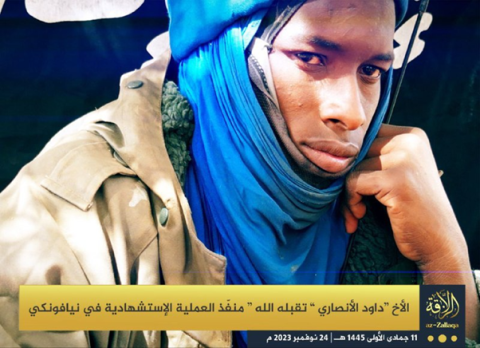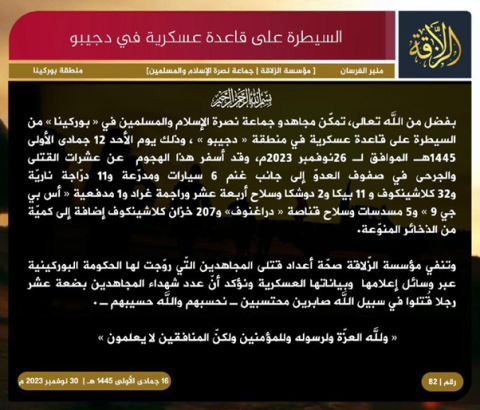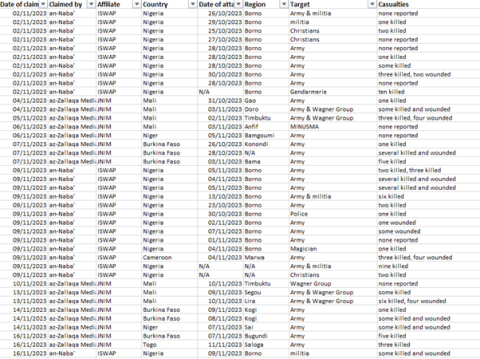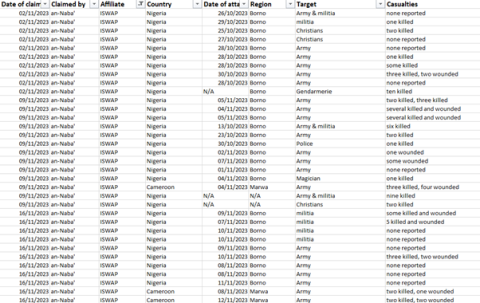Fact:
On April 3, 2017, the day Vladimir Putin was due to visit the city, a suicide bombing was carried out in the St. Petersburg metro, killing 15 people and injuring 64. An al-Qaeda affiliate, Imam Shamil Battalion, claimed responsibility.

The twelfth monthly report monitoring the online propaganda activities of al-Qaeda and Islamic State branches throughout the Sahel will focus on the output of these groups in November 2023. Last month again witnessed over 80 claimed attacks. In November, ISWAP claimed a significant number of attacks. These 45 claimed attacks were the second highest number since monitoring began in December 2022. Only in April 2023, with 46 claims, did the group boast about more operations online. This is noteworthy because in April 2023 the annual Ramadan terror campaign was in full swing, which always sees the highest number of terror activities in the region.
On the other hand, both the number of ISGS as JNIM claims dropped rather significantly. ISGS only claimed four attacks and the number of incidents reported by al-Qaeda’s az-Zallaqa Media dropped from an all-time high of 49 in October to 34 in November. Nonetheless overall November 2023 counted the second highest level of claimed attacks within a single month since monitoring began.
November 2023 was marked by a slow drop in claimed attacks, although the overall level remained very high. This time most of them were claimed by ISWAP, with a total of 45. The majority of these were claims from Nigeria (41), with four other attacks claimed from the Maroua area in Cameroon. As noted before, the Islamic State’s other faction in the area, ISGS, seems to continue its strategy of underreporting with only four incidents claimed, three of them near Inates, one near Tillabéri, Niger. Not a single attack by ISGS was claimed from other countries this month. JNIM, the al-Qaida affiliate in the region with a total of 34 claims, was the only group that really operated on a transnational level. Attacks were claimed in Mali (20), Burkina Faso (11), Niger (2) and Togo (1).
In Mali the Wagner Group continues to be a preferred target for JNIM, with a total of seven attacks on the combined forces of Wagner and the Malian Army, and two directly aimed at the Russian mercenaries. In almost all these attacks a significant number of casualties were reported. There was one incident reported in which a MINUSMA convoy was targeted near Anéfif in central Mali on the road between Kidal and Gao; no casualties were reported.
In what was likely the most significant attack in the entire region in November, JNIM reported extensively on the battle for the Malian Army base of Niafunké, in Timbuktu Province. In this brazen attack, which was featured extensively by az-Zallaqa Media, the entire base at some point was completely taken over by the al-Qaeda affiliate, leading to dozens of claimed casualties. The full-blown attack on the base was preceded by a suicide vehicle borne improvised explosive device (SVBIED) attack by a young man identified as Dawud al-Ansari. Multiple photo sets were released, as was a professionally made video of the entire operation, filmed by a drone.


Another military base was captured in Djibo, Burkina Faso, on November 26. Az-Zallaqa Media claimed dozens of casualties in the ranks of the Burkinabe army in connection with this attack. The base was plundered, and again az-Zallaqa eagerly reported on the attack with a significant amount of audio-visual material.


Table 1: Claimed Attacks (December 2022 – November 2023)

Table 2: Claimed Attacks per Group (December 2022- November 2023)

Table 3: Claimed Attacks per Country (December 2022 – November 2023)

In November 2023 the second highest number of attacks were claimed by ISIS and al-Qaida affiliates in the region since reporting began, with a total of 83 claimed attacks throughout the Sahel. Due to the rise in claims coming in from ISWAP and only a slight decrease in az-Zallaqa Media output, it is reasonable to conclude that Nigeria (41 attacks) and Mali (20 attacks) were most affected by Jihadist attacks over the last month. It is remarkable that the number of attacks claimed by ISWAP in November is nearly double the monthly average number of claims by the group since the end of the annual Ramadan campaign in April.
The number of attacks in Nigeria has reached a peak. For the first time the amount of claimed attacks has risen above 40. Similar to previous months, most of these attacks were of minor impact, causing minimal structural or physical damage to the Nigerian Army. Unsurprisingly, some of the propaganda content indicated that an extremist interpretation of Islamic Law is introduced in the regions that are under ISWAP’s control. Sectarian violence targeting Christian communities also continues. In Borno Province at least 10 Christians were reportedly killed by ISWAP over the last month. Other remarkable events were the killing of a so-called “magician” and an attempted attack on the convoy of the governor of Yobe in Borno. The “magician” was executed and two bodyguards in the governor’s convoy were supposedly killed in the attack.
Last month, Mali was undoubtedly the country affected most by the Jihadi-terrorist insurgency in the Sahel. Most remarkable were not only the continuous attacks on the Malian Army and Wagner Group, but above all the successful attacks on army bases throughout Mali, such as the attack in Niafunké. It it is clear that JNIM continues to be the terrorist group that gains most from the current instability in Mali and the wider region. Since Burkina Faso and Niger also terminated their cooperation with Western led military operations and security structures such as the French Operation Berkhane, the UN MINUSMA, the G5 Sahel and others; Jihadi-terrorist groups keep on capitalizing on the inability of local regimes to further destabilize the security environment. Meanwhile it has been reported frequently that mining and other economic activities by groups such as Wagner and other Russian state-controlled agencies are increasing steadily in the region. This is not only draining the natural resources of the countries affected but also enriching Russia, providing it with resources that are most likely used in the war against Ukraine.
Burkina Faso witnessed a total of 11 attacks throughout the country, all claimed by al-Qaeda’s affiliate JNIM. Some of these attacks were of major impact, especially the attack on the military base of Djibo on November 26. Az-Zallaqa Media claimed a complete takeover of the base leading to dozens of killed and wounded in the Burkinabe army. Vehicles, weapons, and ammunition were looted. Az-Zallaqa published an 11:04 minute video of the attack.

In Niger two low-impact attacks were claimed by JNIM. The group with the most impactful operations in the country in November was ISGS, and all four claimed attacks by the Islamic State originated from the area of Inates. The most important event reported was the siege of a military base in Inates by this ISIS affiliate. The siege continued for several days. Within the span of eight days, three separate attacks on the base were reported.
Four small case attacks in Maroua province were claimed by ISWAP.
One attack by JNIM reportedly resulted in the killing of three Togolese soldiers.
Table 4: Total number of attacks



34 attacks were claimed via az-Zallaqa Media on behalf of JNIM. Mali, Burkina Faso, Niger and Togo were targeted by al-Qaeda’s Sahelian branch. As previously stated JNIM’s attacks and raids were mainly targeted at the Malian Army and the Wagner Group, but the al-Qaeda affiliate was also responsible for the November 26 takeover of the Burkinabe Army base in Djibo.
Furthermore, as JNIM continues to portray itself as the protector of the people, on four occasions claims were spread on its propaganda channels of war crimes allegedly committed by the Malian Army, the Wagner Group, or the Burkinabe Army.
Table 5: Attacks by JNIM

The Islamic State’s Western Africa Province claimed the majority of all reported attacks, 45 attacks. Of these, 41 occurred in Nigeria and 4 in Cameroon. Five attacks in the Borno area were directed at the Christian population. Most of the attacks targeted the Nigerian Army or supporting militia. One attack in Borno province stands out: the convoy of the governor of Yobe was attacked on November 18. Two of the governor’s bodyguards were killed in the attack.
Table 6: Attacks by ISWAP


Only four attacks by ISGS have been claimed throughout the entire month of November 2023. This is again a very strong indication that ISGS is deliberately refusing to claim the majority of its operations. All four claimed attacks occurred in Niger, three in the area of Inates, targeting the Nigerien Army. The last one was an attack in Tillabéri on an alleged “spy” working for the former French military operation Berkhane.
Table 7: Attacks by ISGS

As in previous months, instability and chaos in the entire region is spreading like wildfire. For the second month in row, the three terrorist groups CEP monitors claimed more than 80 attacks in four weeks. This means that the average number of monthly attacks has doubled since monitoring began in December 2022. Given the current situation and the deteriorating ability of government forces to stem the tide of terrorist violence in key countries in the region, including Burkina Faso, Mali, Nigeria and increasingly also in Niger, it is likely that the situation will worsen throughout the coming months. This does not bode well for 2024 and given current trendlines, it is not unreasonable to assume that in 2024 the average number of monthly attacks will increase to over one hundred claims, even if the systematic underreporting of attacks by ISGS continues.
Extremists: Their Words. Their Actions.
Fact:
On April 3, 2017, the day Vladimir Putin was due to visit the city, a suicide bombing was carried out in the St. Petersburg metro, killing 15 people and injuring 64. An al-Qaeda affiliate, Imam Shamil Battalion, claimed responsibility.
Get the latest news on extremism and counter-extremism delivered to your inbox.